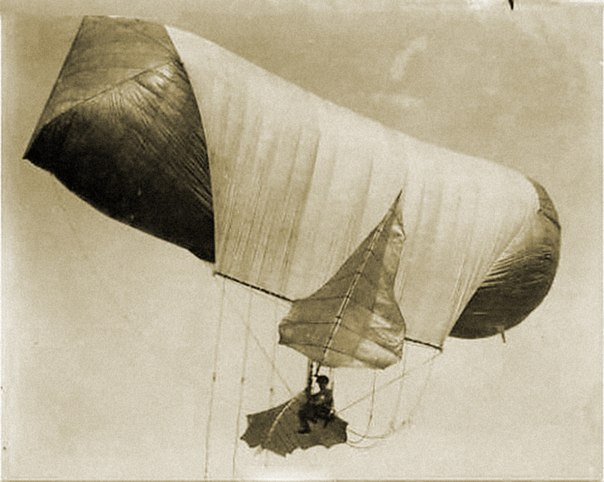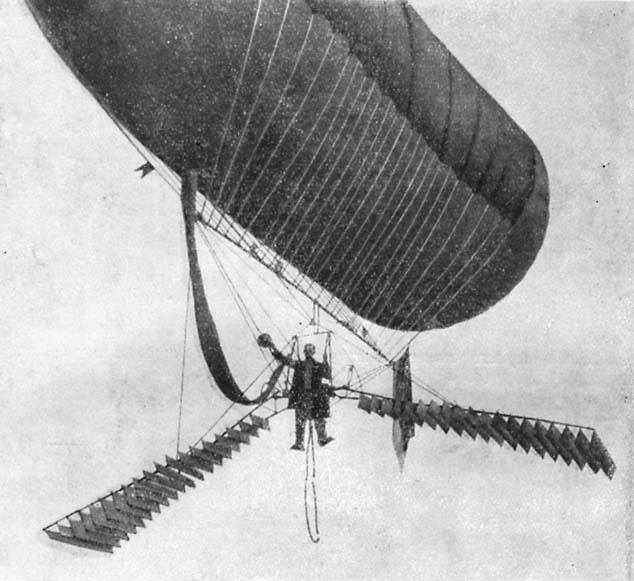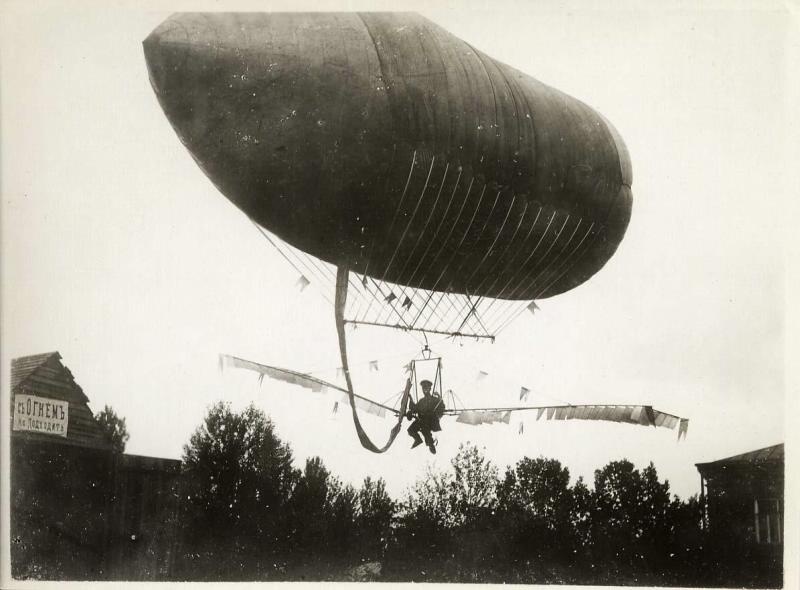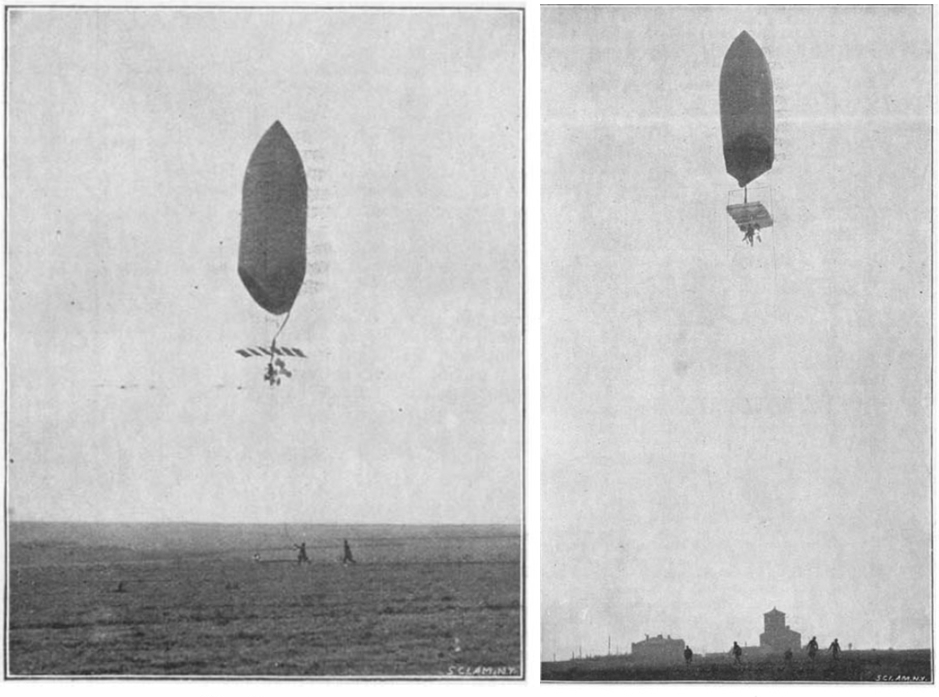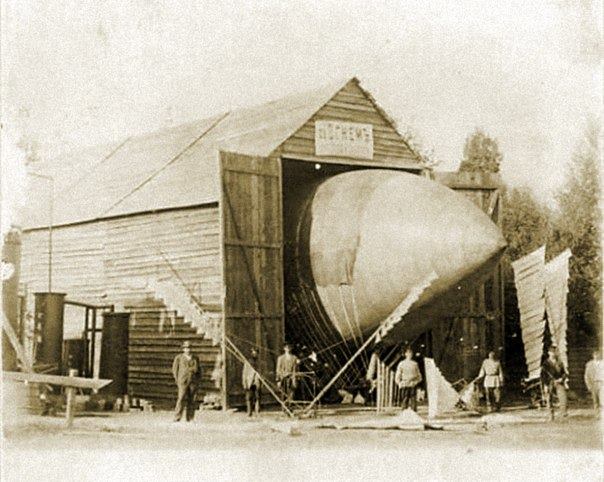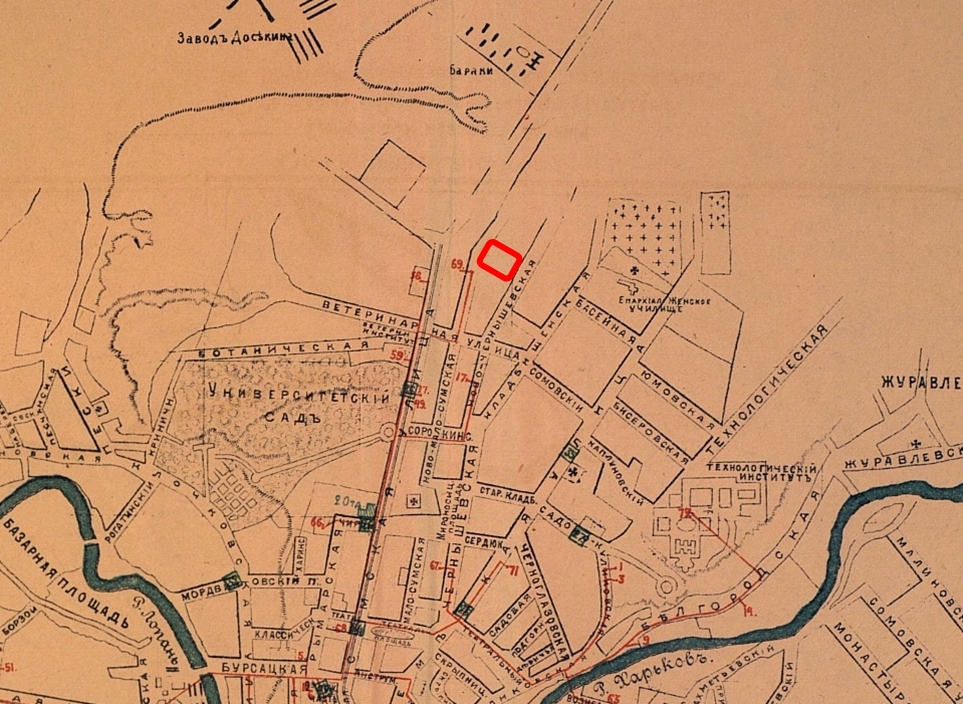The first Danilewsky airship: The "Embryo"
Figure 1. Photo credit: Public domain
This very fine, detailed photograph was taken in October, 1897 in what is today Kharkiv, Urkaine. It is Danilewsky's first of four airship designs, developed with the goal of methodically uncovering the many nuances of flight at a time when human flight was still on the distant horizon. Danilewsky received a patent for this design on October 22, 1897.
This was, for me, in all my years of airship research, a terrific and rich discovery!
In the late 1800's, when Zeppelin was beginning his work in Germany, and Santos-Dumont had not yet built his first airship, a man by the name of Konstantin Danilewsky, (b. 1857, d. (?)), a physician from Kharkiv (then Kharkov, Russian Empire), had already patented his ideas for an airship powered by a human! This was nearly a decade before Alva Reynolds or Thomas Baldwin in the United States both tested and flew their own man-powered dirigibles: See Man Angel on this site.
Konstantin Danilewsky built and tested 4 airships in the years just preceding 1900. His log-book documents, during the years 1897–1899 nearly 200 ascents, and unlike many pioneers of aviation in this era, exactly the same number of safe landings! In the sections which follow, I will illustrate each one of these airships as best as I can, given that the great majority of historical information about the Danilewsky work is in Russian or German.
Please note, I have endeavored to include an acknowledgments section at the end of this article. I am most grateful for the help I received.
Danilewsky's Vision
Danilewsky is mentioned in several publications of the era, including Scientific American, and his work was evaluated by two great Russian scientists, the aerodynamicist Nikolaj Zhukovsky and rocketry theorist Konstantin Tsiolkovsky. In 1900, Danilewsky himself published a small, 82 page, book about his work in which he describes his vision in his own words:
"When I was still a student, I frequently thought that it would be very simple and easy to arrange a flying apparatus so that at the command of the aeronaut (he could) ascend into the air, descend, or stop and motionless in the air and generally maneuver; and all this can be done as many times as necessary without discarding any ballast and without releasing the (lifting) gas. To do this, you just need to lighten the weight of a person with a hydrogen balloon; but not completely - rather to leave some of its weight with an unbalanced balloon, and now the man himself will raise the remaining weight by his work on his wings: when he works, the apparatus rises into the air; will he ceases to work - it will lower."
Figure 2. Photo credit: Public domain. Image links to a PDF copy of the book, "AirBike...1897" containing
Danilewsky's 1900 book in Russian, German, and English.
The image above is the title page to the recently published work "AirBike...1897" a free, 342 page PDF book containing Danilewsky's original 1900 book titled "A Steerable Flying Apparatus" in Russian, German, and English:
Danilewsky's 1900 book, about 88 pages, was written at the end of a brief period of experimentation and is filled with insight and discovery presenting the culmination of his three years of work from 1897-1899. It was published in Russian and German at that time. The work was largely lost to history with the rapid progress in aviation in the early 1900's. Danilewsky's magnificent work faded, quite unnoticed until, by chance a copy of the book in Russian was found by Dr. Alexander Akimov, Ukraine, whose vision to re-publish the work led to this work "AirBike...1897", where for the first time the lost book is rendered in English. (The cover page image above is linked to the book "AirBike...1897", hosted at airbike.welweb.org). All students of aviation history are encouraged to spend some time with this newly available resource.
Danilewsky's idea was that he would build an airship, not quite buoyant, which would offset the weight of the airship itself and most of the weight of the pilot. The pilot then, using his own muscle-power would become the "engine", operating the propulsive mechanism, in this case "oars" (or "wings") instead of a propeller driven by a petroleum engine.
But Danilewsky repeatedly set aside his vision, putting it in a "box", he writes, resulting in years of simply thinking about his idea from time to time. Danilewsky states: "Sometimes, you take the idea out of the box, and you admire it and again carefully hide it - in the same box. And so it dragged on for many years."
In 1894, Danilewsky is reported to have made a model of his idea. One description of this model says: "The device had an 'airplane plane' about 20 meters long and about 13 meters wide (about 60 x 42 feet!), similar to a mattress. It consisted of a light frame and attached to it several dozen cylindrical cylinders of hydrogen. To the frame on the slings was hung a seat for an aeronaut with a pedal mechanism. Rotating the pedal, the balloonist set in motion a vertical air screw." [Note: In the late 1800's an "airplane" was any (nearly) flat object/device intended to move through the air horizontally with its surface forming a "plane" against the air. Hence the name "air-plane". Think of a piece paper held in the air. The paper is a "plane", and in the air it is an "air plane". Today, of course, the term conjures up a more familiar image.]
It's a bit hard to imagine the "model" of "20 meters long and 13 meters wide" as those dimensions are larger than anything Danilewsky ever built! Presumably the model was sub-scale, perhaps 2 meters by 1.3 meters (about 6 x 4 feet), so he could illustrate his concept to interested parties in search of funding. Danilewsky writes: "...she obediently flew in all directions at will; many people saw it; but there was not an investor among them to go with me on a voyage on the waves of chance and risk." (Here Danilewsky aptly describes his need for a benefactor to support the cost of building and testing a full-scale airship.) The model was evidently large enough to fill with hydrogen and likely conducted only tethered flights. Finding no investor, Danilewsky once again "shelved" his idea in the box until 1897.
In that year, Danilewsky refurbished the model and demonstrated it again. This time he found his investor - philanthropist Andrei Andreevich Pilström! So grateful was Danilewsky, that he wrote in his 1900 book "May his noble name be eternally connected with this young, universal human cause." That same year, Danilewsky ordered the hydrogen envelope for his first "real" airship from the Lachambre brothers of Paris, who were in the business of making balloons. This first airship was the "Embryo" (see below) for it was the "seed" or "germ" of his grand idea. The Lachambre brothers would play a role in the ultimate failure of Danilewsky's dream. More on that as you read a bit of this marvelous though little-known history...
Identifying Danilewsky Airships
Anyone encountering the historical record of the Danilewsky airships will quickly discover confusion as to which of the four Danilewsky airships is which! This is similar to the confusion as to the identity of the American Reynolds and Baldwin airships (see Man Angel). Curiously, though misidentification of airships is not infrequent, (it happens quite a lot!), it is interesting to note that the link here between the airships of Danilewsky, Reynolds, and Baldwin is that they are all "man-powered" airships!
Danilewsky No. 1, the "Embryo"
Figure 3. Photo credit: Public domain. From Danilewsky's book, page 6.
Other than Figure 1, above, the only other photos of the Embryo found during my research were in Danilewsky's 1900 book. It is Danilewsky's first airship and its design is remarkably close to the drawing of his idea in his 1897 patent (see Figure 4).
Specifications1:
- Length: ~36 ft (11 m)
- Max Diameter: ~12 ft (3.6 m)
- Envelope ratio (L/D): 3.0
- Operating dates: 8 October 1897. (Some 25 ascents made according to the Dec 31, 1898 issue of Scientific American magazine).
- Visual: Visual: Elongated envelope, rounded stern and a cruciform shaped bow, and a single spar which acts as a keel. A "blanket", supporting ropes, surrounds the envelope and descends to attach to the keel spar. A frame basket is suspended from the middle of the keel to support a single pilot. "Wings" extend from the pilot's basket which are operated by the pilot using his feet to "wave" the wings up and down. The pilot and basket can "tilt forward" thus changing the angle of attack of the wings such that horizontal propulsion was possible.
1(Given the dimensions derived for the Pilström by Dr. Alexander Akimov (see Pilström, below), using the waist-height of 3 ft derived for pilot Peter Kosiakov (the only pilot of all 4 of the Danilewsky airships), the dimensions of the Embryo are derived.)
Danilewsky's idea, remember, was that if an airship could be just the right size to compensate for not only its weight but also almost all the weight of the pilot, then the pilot could act as the "engine" using his own muscle power to provide propulsion. In Danilewsky's time, light-weight gasoline engines were not yet available, and though Danilewsky recognized the obvious benefit of using a gasoline engine, he sought to solve the problem of flight in a practical, step-by-step manner such that when the light-weight gasoline engine inevitably became available, it would be a simple matter to outfit the craft with a mechanical engine.
Figure 4. Drawings from Danilewsky's 1897 patent. Photo credit: Public domain.
Not much is known about flight tests of the Embryo. It can be speculated that flights of the Embryo were not encouraging. The "nose" of the envelope was, according to Danilewsky's patent, intended to be far more "pointed" (i.e. a steeply shaped "V"), to reduce air resistance as the craft was propelled forward. (Daniliewsky was keenly aware of and sought to reduce air resistance as much as possible.) As can be seen in this photo of the Embryo, the builder of the hydrogen envelope did not provide the desired, steep "V" shape of the nose! Additionally, the method of attaching the keel to the gas-envelope using a blanket wrapped around the gas-envelope no doubt proved "heavy". Indeed, the craft could not lift Danilewsky, who had intended to fly it himself. Danilwesky arranged for a young mechanic named Peter Kosiakov to fly the craft for him. Young Mr. Kosiakov went on to fly all four of Danilewsky's brilliant airships!
Given the late date of the first flight of the Embryo (Oct, 1897), and its likely disappointing performance, it would not be beyond reason to ague that the Embryo's only flights were that day! Danilewky writes in his book that he barely got the Embryo's envelope filled with hydrogen before his hydrogen generation plant "collapsed". He concludes "The experience was a success; and we made a series of tethered and free lifts into the air and descents."
Regarding the Embryo's performance, Danilewsky writes: "I will not speak here of the shortcomings of my first apparatus-for there are thousands of them: this apparatus was the essence of maladroitness; but at that time, in the air, she seemed to me a wonderful winged Pegasus." But the Embryo was too heavy and maneuverability was clearly a problem. The oars were heavy and cumbersome and required redesign to be lighter and more responsive. Dr. Danilewsky no doubt had ideas for the next version of his dream!
Danilewsky No. 2, the "Pilström"
Sometimes written in English as the "Pilstrom" or "Pilstrem", it is named after Danilewsky's benefactor Andrei Andreevich Pilström who provided funding for Danilewsky's experiments until he died suddenly (sometime in early to mid 1900(?)).
Figure 5. Photo credit: Public domain
Specifications2:
- Length: ~43 ft (13 m)
- Max Diameter: ~14.5 ft (4.4 m)
- Envelope ratio (L/D): 3.0
- Operating dates: 1st ascent, 18 Jun 1898. Numerous ascents - up to 150 conducted - through the summer of 1898.
- Visual: Elongated envelope, sharply pointed bow while very rounded at the stern, projectile or bullet shaped. A single spar acts as a keel. The "blanket" of the Embryo has been replaced with a lighter "netting" over the envelope from which lines (lanyards) around the envelope descend to attach to the keel spar. Like the Embryo, a basket is suspended from the middle of the keel to support a single pilot. Various photos of the Pilström show not only that many types of "oar" designs were tested, but the airship itself seemingly was constantly modified. (See additional photos, below).
2(The approximate length and diameter were assessed by Dr. Alexander Akimov of Kharkiv, Ukraine, who rendered volumetric models of the Pilström based on published accounts of the craft.)
The Pilström was the "workhorse" of Danilewsky's ideas. Reported to have had at least 150 ascents in the summer of 1898, Danilewsky had the opportunity to evaluate oar shapes, oar operation, the most advantageous mounting point for the oars (high or low - at the pilot's shoulder level or at his waste), the securing of the pilot's sling, and the conduct of flight: ascent, descent, turns, capability against the wind, etc.
The Pilström also exhibited innovations which are not visible in any photo. Concerned with "longitudinal stability" of a horizontal balloon, Danilewsky solved the problem himself. First a word about longitudinal instability:
Longitudinal instability in an airship is encountered when the hydrogen contracts thus reducing pressure in the envelope and causing the envelope to "slacken". The resulting slack permits the envelope to become flexible and the hydrogen then, gathers at whichever end of the airship's envelope happens to be the path of least resistance for the hydrogen to find a "high point". That pooling or gathering of hydrogen at one end of the gas envelope, of course, causes greater lift at that end, and the axis (pitch) of the airship is affected. Say the airship has pitched down since the hydrogen gathered aft. If the pilot applies power to the engine to "force" the airship to return to level, the hydrogen simply flows forward in the slackened envelope, consequently shifting the lift at the nose, and the airship begins to pitch too high. This is the instability. Non-rigid airship designers solved the problem with an internal "ballonette" - a separate balloon inside the hydrogen-filled envelope - which could be pressurized with air to maintain the interior pressure of the envelope so the envelope never "slackened" and the hydrogen never "pooled" at one end or the other.
Danilewsky wrote that he was unable to learn how others handled the problem of longitudinal instability. He therefore solved the problem himself! His innovative solution was to install a series of transverse silk partitions inside the gas cylinder, making it difficult to transfuse the gas from one end to the other. As the hydrogen expands or contracts as it heats or cools, the gas is constrained within the envelope by these partitions so that large volumes of hydrogen could not "suddenly" migrate from one end to the other when the overall pressure in the envelope was reduced. Danilewsky's solution was brilliant, for he did not have a petroleum engine, driving a propeller which, in turn, provided the air to pressurize an internal ballonette!
Available photos of the Pilström hint at the many external changes made as Danilewsky put the craft through its many tests. Here are a few photos to illustrate. The photos are in no particular order because it is impossible to accurately assess the dates of the individual photos so as to present the photos in order.
Figure 6. Photo credit: Public domain
Figure 7. Photo credit: Public domain
Figure 8. Photo credit: Public domain
Figure 9. Photo credit: Public domain
Danilewsky No. 3, the "Orichka"
The Orichka is a bit of a mystery. Since flights of the Pilström took place throughout the summer of 1898, beginning in mid June, and the only known flights of the Orichka took place on 5 & 6 August of the same summer, it is reasonable to assume that the envelopes for both crafts were procured from Lachambra in Paris in the same purchase order. The gas-bag/envelope (Danilewsky simply calls it "the balloon") for the Orichka appears to be the same design as the Pilström, and was reported to be about the same volume, but the Orichka was longer (by about 12 feet (3 meters)) than the Pilström, and would necessarily need to be somewhat smaller in diameter than the Pilström to contain the same volume. There are few photos of the Orichka which can be decidedly determined to be the Orichka and which are not mistaken as the Pilström. The absence of photos and the only known flight dates of 5 & 6 August suggest not many flight tests were conducted which suggests Danilewsky was somehow not satisfied with the performance of the Orichka.
Figure 10. Photo credit: Public domain.
Specifications3:
- Length: ~51-55 ft (15.6-16.7 m)
- Max Diameter: ~13 ft (4 m)
- Envelope ratio (L/D): 4.0
- Operating dates: 5 & 6 August 1898
- Visual: Similar appearance to the Pilström, but a noticeably longer hydrogen envelope and keel-spar.
3(There are few photos of the Orichka and no dimensions provided in any document found to date. The dimensions presented here are derived from the known (assumed) waist-height of pilot Peter Kosiakov (about 3 ft) and an estimate of the angle off perpendicular of the photo of the Orichka.)
If I may be permitted to speculate: The Pilström and the Orichka are reported to have been "about the same volume" but the Orichka was longer by about 12 feet (3 meters). What would Danilewsky have been thinking? Since he likely ordered the envelope for the Pilström and the Orichka at the same time, the difference in the envelopes most decidedly was not due to experimental results! Rather, Danilewsky might have had some doubts about the best shape of the envelope, against which he was hedging his bets. If one design worked well, all is good. But if one does not work, there is the other! My guess is that Danilewsky was not comfortable with his computations and estimations of just what length-to-diameter ratio would function the best for an airship powered by his human engine. Perhaps he had doubts that his solution for longitudinal stability would work? Perhaps it was his concern about air resistance that led him to two different envelope designs. Whatever the reason, we may never know because Danilewsky did not write about the successes or shortcomings of the Orichka over the Pilström.
Danilewsky No. 4, the unnamed variation simply called the "1899" version.
Danilewsky long thought about the best solution to overcome air resistance of the envelope during ascent. Most of the pilot's energy was expended ascending. You get a sense that Danilewsky was most troubled by the effort it took for his pilot (the human-engine) to overcome that unforgiving resistance to climbing. Also concerned about longitudinal stability, he fully recognized that a vertically oriented balloon would go a long way to solving both problems! The pointed end of a vertical balloon would produce far less air resistance during ascent, and the vertical orientation of the balloon would have absolutely no longitudinal instability!
An entirely new airship design was planned for the 1899 tests, including a radical new balloon which, oriented vertically, would also be steeply pointed at both ends. A plane-surface (in those days called an "airplane", remember, in the late 1800's what we know today as the "airplane" did not exist) which would act as a "parachute" to control both decent and horizontal displacement.
Figure 11. Photo credit: "La Navigation Aérienne-Histoire documentaire et anecdotique". Public domain.
Specifications4:
- Length: ~55 ft (16.7 m)
- Max Diameter: ~13 ft (4 m)
- Envelope ratio (L/D): 4.0
- Operating dates: Late September and October 1899. About 40 ascensions before weather prevented any further testing.
- Visual: An envelope is positioned vertically (unique to Danilewsky). In the design, both ends of the envelope are pointed. Instead, the envelope procured from the Lachambre brothers in Paris had construction flaws which needed correcting before use. Lacking time for 1899 experiments, Danilewsky instead employed the envelope for the Pilström from 1898 for this season's experiments. Underneath the envelope was a rectangular "frame" (the "airplane", refer to the photo above) with louvers which could be opened or closed as needed to assist ascent or inhibit descent. A twin set of 4-bladed paddle propellers were situated on the left and right and slightly behind the pilot which could be oriented to provide desired propulsion up, down, left, or right.
4(There are also few photos of the 1899 and no dimensions provided in any document found to date. However, the available record indicates the envelope used was the same as that used in the Pilström and/or the Orichka - (see text). Danilewsky reports that the enveloped ordered for the 1899 did not meet his specifications, so he conducted some flight tests with the envelope of the Pilström even though the lower end, which could not support itself, appeared "ugly" with creases and folds which would have not been present if the envelope he had ordered for the 1899 version had been properly constructed. Measurements of the apparent dimensions from the few photos found of the 1899 do result in envelope dimensions the about the same as the Pilström.)
As mentioned in the "Visual" specification, above, the "airplane" suspended below the balloon was designed with "louvers" which could be controlled by the pilot to be "closed", "open" or set to any angle in-between. Open, the louvers permitted free-flow of air through the airplane offering the least resistance. Closed, the louvers created a resistive surface, such as that of a parachute, against air flow. The louvers positioned instead at an angle, caused the direction of airflow through the airplane to be displaced as the craft ascended or descended, thereby imparting a slight horizontal displacement which could be controlled by the pilot.
Figure 12. Photo credit: Scientific American Jan 20, 1900, pg 43. Public domain.
The pilot sat in a "trapeze" or "sling" suspended from sides of the balloon and the airplane. Not only could the pilot control the position of the airplane louvers, but he had a dual set of propellers on either side, slightly behind him, that he could activate using his leg power like a bicycle. The pilot could, through an ingenuous coupling mechanism, set the propellers to force air "down" or "up", thus ascending or, when descending, add to the speed of the descent.
So the intent of the 1899 vertical design was to have a streamlined gas envelope pointed at both ends, configured vertically to minimize air resistance as the airship ascended or descended. But Danilewsky writes in chapter 4 of his book that the envelope for the 1899 version received from the Lachambre brothers of Paris was received late (which he admits was his fault) and "had shortcomings" which, though correctable, did not permit him time to conduct flight tests during the remainder of the summer of 1899 before the weather turned too poor for flights. In virtual despair, with limited funds, and time running out, he assessed proceeding with his experiments by using the balloons of the Pilström and/or the Orichka. He decided he could do that, and by late September, he had constructed the 1899 airship and began testing. [At this point, I should make the reader aware that in all photos of the 1899, the lower-end of the balloon appears uninflated, and distorted. Danilewsky hated that appearance! He called it "ugly"! His intent was for the balloon to be held rigid at the lower-end by a set of vanes but the Lachambra builders provided a balloon which did not meet his design! Thus, the 1899 airship looks like the lower part is collapsing, because unfortunately, it is! Circumstances forced Danilewsky to use his existing balloons which were not designed to be used vertically.]
Even with a balloon which did not meet Danilewsky's design goal, operations were ingenious and simple. For ascent, the pilot would ensure the louvers of the airplane were "open" so as not to restrict airflow and the double propellers would be configured to push (down) for lift. After ascending to the desired altitude, the configuration of the propellers was adjusted to push in the opposite direction while the louvers in the airplane were adjusted to an angle so as the craft descended, a slight horizontal component of motion was imparted. Thus, as the craft descended, it was also displaced horizontally. At a safe, low altitude, the louvers would be opened, and the propellers adjusted to provide lift and the pilot would propel his way back to altitude.
This method of navigation worked in both still air and in light wind the only difference being that in light wind, the entire craft was displaced laterally as it ascended. Here is a drawing from Danilewsky's book showing how the vertical airship ascended and descended to produce a horizontal displacement:
Figure 12. Photo credit: Public domain. Danilewsky's book "A Steerable Flying Apparatus", 1900, pg 26.
In the illustration, above, the solid line represents the flight path in still air. The pilot drives the craft vertically to the desired altitude, with the airplane louvers fully opened. Upon ceasing operating the propellers for ascent, the pilot then adjusts the louvers to an angle, and sets the propellers to direct their thrust downward for the purpose of accelerating the decent. As the craft rapidly descends, the airplane louvers impart a horizontal component of motion. At the lowest desired altitude, upon setting the propellers again for ascent, the louvers are adjusted to an angle to favor the desired continued horizontal component, and the pilot drives the propellers once again to ascend. Thus, in still air, the craft is maneuvered, at will, in the desired direction of flight.
On the other hand, against light wind, the flight path is represented by the dashed line. The flight path is essentially the same except that the wind imparts a component of drift opposite the desired direction of motion. All other aspects, the actions of the pilot, and the settings of the propellers and airplane louvers remain the same. The most significant impact of a (light) wind is that it takes more ascent/descent cycles to travel the same distance.
In actual test flights of the 1899, since Danilewsky was forced to use an earlier balloon, not designed for vertical operation, and the decent, even in still air, was most certainly hindered as the lower-end of the balloon must have acted as an additional parachute-like resistance. Nevertheless Danilewsky writes of success and setbacks in a series of flights in September and October, 1899 - experiences typical for this sort of developmental program. The concept was proven, though not made practical, much to the dismay of Dr. Danilewsky.
Here is one extremely interesting Danilewsky concept I think is worth a note. Since the pilot was causing the airship to travel horizontally quite unpredictably, and it was not possible to have "ground crew" waiting for the pilot's final descent, upon descent the pilot would extend his feet from his pedals, permitting his feet to first contact the ground! "The feet of the aeronaut," Danilewsky writes, "in this case, play the role of a spring." Further, if the pilot desired to stay on the ground, in the next moment after touching-down, he would screw into the ground a specially adapted drill! The pilot then, with the craft anchored, was then free to exit the craft without a ground crew present! Compare this technique to that of the European Space Agency robotic "Philae" spacecraft which attempted to land on comet 67P/Churyumov–Gerasimenko on 12 November 2014. Philae had "anchor harpoons" which were supposed to secure the spacecraft to the comet moments after the spacecraft contacted the comets' surface. The harpoons did not work and the tiny spacecraft rebounded off the comet. Perhaps Danilewsky's method should have been evaluated by the European Space Agency's Philae team!
Ignominious End
Danilewsky's ideas were nothing short of brilliant. While he fully recognized that his efforts were "premature" in terms of resulting in a practical airship for common travel since a gasoline engine light enough to mount on an airframe suspended from a balloon was not available in his time, he knew that this concept of flight could still be examined and tested using human power. In this goal, he succeeded even though, as fate would have it, the rest of the world had "moved on", collectively fantasizing about the efforts of world-wide experiments with heavier-than-air flight and with the effort of several nations to build large, fully dirigible airships powered by engines of which the engine's weight was not such a hindrance because the balloon itself was large enough to compensate and against which no individual could hope to compete.
The press was unkind to Danilewsky, unjustly in my opinion. He was invited to speak to the aeronautical subsection of the Tenth Congress of Naturalists and Physicians in Kiev in August, 1898. Danilewsky reports that his report "went almost unnoticed". Aviation journalists were most unkind making statements that Danilewsky's work "offered nothing new to aviation". Sometime in the period 1898-1899, Danilewsky's only benefactor, A. A. Pilström, had died. By summer of 1899, Danilewsky had exhausted his many appeals for new benefactors, and having ordered the envelope late for his 1899 vertical airship, the balloon arriving late for summer testing and which failed to meet his specifications, thanks to the apparent inattention by the Lachambre brothers, he was forced to test, as summer ended, using the envelope of the Pilström and Orichka gas-envelopes. Upon completion of his (rather successful) tests in October that final year, funds exhausted, Danilewsky had to "throw in the towel" so-to-speak.
Danilewsky wrote, likely with his detractors in mind: "Stubborn people who recognize only a complete solution to the problem of flying a man will wait long for their winged Pegasus; but there are others, more practical, who will be content with what is now at hand. These people, with unshakable hands vigorously tackling the matter, with thousands of experiments over several years will develop manned flight to the sublime solution and will bring aircraft to perfection."
Indeed. He was right.
Sites of Interest
Kharkiv, Ukraine
There is a wonderful photo, reproduced below, showing the Pilström partially emerging from a hangar as men stood for the camera displaying the many "oar" (or "wing") designs of the Danilewsky idea and dream. I never imagined I could identify the location of this amazing image! Usually, something in the image must still remain, today, which can identify the location, but here, I had nothing - no visual clue! However, researchers of Kharkov history have identified it! This airship hangar was located at Mironositska 50, an address which still exists today in Kharkiv, Ukraine!
Figure 13. Photo credits (above): Public domain
This was the site of Danilewsky's airship operations in 1897 and 1898. (Sometime in 1898, Danilewsky built a second operations site outside of Kharkiv, near Rogan (see below). But it was here that the Embryo was built and inflated, and it was here where Danilewsky's initial hydrogen generator "collapsed" just as the Embryo had been filled. In this photo, above, you can just see most of Danilewsky's more robust hydrogen generator in the lower-left corner. The large sign above the large doors of the airship shed reads in Russian: "съ ОГНЕМ не подходить", "DO NOT APPROACH WITH FIRE"! Note also that the Pilström was not just stored in this shed, but that it as flight tested here. See Figure 9, above - the shed is seen in the lower-left corner of the photo.
Here is a photo of the location today courtesy of Google Earth. The view is looking to the Northeast at the corner of Mironositska and Petrovs'koho St/(Yaroslava Mudrogo St.). If this view were in 1898, you would be looking pretty close to the back side of the two-story tall airship shed! When an airship was brought out of the shed, it would have been seen over this very location!
Figure 14. Photo credit: Google Earth.
And here is the map view in Google Maps, (Lat Lon) 50.007031 036.239568. (Note there is a change of the street name between Google Earth an Google Maps. Google Maps refers to "Petrovs'koho St." as "Yaroslava Mudrogo St.":
Figure 15. Credit: Google Maps.
The change in the street name, depending on the date of the map, does not matter because in the time of Danilewsky's work, the cross-street did not yet exist! Here (below) is a portion of a very fine map of the area from 1889. The area which is today "Mironositska 50" is highlighted with a red oval. The cross street did not even exist at that time! The street БАСЕЙНАЯ (Bassejna), at that time, had not yet been extended to today's "Mironositska" street!
Figure 16 Credit: Public domain.
The point is, that the location of Danilewsky's 1st airship shed, at what is today known, today, 120 years later, as Mironositska 50, is known! This aspect of the history of Kharkiv is beyond dispute and is most exciting!
"Hippodrome", Kharkiv, Ukraine
A Hippodrome, is a race track, typically for racing horses. In the period 1897-1899 that Danilewsky was building and testing his airships, the area of the Kharkiv Hippodrome was a vast, open space, there seems no question that from his airship operations at Mironositska 50, he would have transported his airship through he streets to the Kharkiv hippodrome where he could then conduct flights without fear of dangerous obstacles. Indeed, Danilewsky writes in Chapter VII of his book, that "After the examination of the terrain, the aircraft, remaining charged [i.e. with hydrogen], can be freely transferred to another place by two or three people. For convenience of transport, small bags (of sand) can be hung along the balloon's keel to balance its lifting force [since it would not be carrying the weight of the pilot]. The aircraft can also be moved from place to place, remaining in the air with an aeronaut." Several photographs of the Pilström reveal a background of a wide-open area with some trees which may be the trees along what is today the Belgorod Highway from Kharkiv in the open area of the hippodrome. A couple of examples of such photographs of the Pilström are provided here:
Figure 17. Credit: Public domain.
Figure 18. Credit: Public domain.
These photos do not appear to fit the time-frame of Danilewsky flights at Rogan, and the expanse underneath the Pilström in-flight suggest that the photographs were some distance from the shed at Mironositska 50. Indeed, landing the Pilström would have required some latitude, an open area, and it was not likely that Danilewsky would have expected his pilot to precisely navigate the craft back to the shed at Mironositska 50, which would have been a difficult and dangerous operation. (Danilewsky writes in Chapter IV of his book that on September 10, 1899, during a descent of the 1899 airship at Rogan, a propeller was damaged as the craft settled against the roof of the airship shed. Danilewsky was keen on avoiding injury to his pilot suspecting that any injury would lead to a prohibition of his experiments.)
Here is the likely location of the hippodrome in Danilewsky's time:
Figure 19. Credit: Public domain.
The hippodrome was just over 3/4 a mile (1.2 km) from the Danilewsky operations at Mironositska 50.
Today, a track still exits in the same area, (Lat Lon) 50.015474, 036.251745 ,as well as an air field just to the NE of the track:
Figure 20. Credit: Google Maps.
Rogan (Rohan'), Ukraine
As already mentioned, Danilewsky built a second airship operations location near Rogan. A very nice photo of the airship shed build there is reproduced below. It shows the Pilström in front of the shed. The shed is known to have been near the railroad tracks which ran, and still run, at Rogan! An article in the Russian "Ballooning Magazine" writes:
"At the beginning of 1899, the Kharkov Provincial Gazette wrote: 'When the train approaches the village of Rogan, recently constructed buildings of a strange kind are being built near the railroad tracks.' It was the hangar and the fantastic apparatus of Konstantin Danilewsky. Here, outside the city, he moved his 'test station'. From here he demonstrated the incredible, as it looked then, flying his 'Ornithopters' and 'Flying Carpets'..."
As the 1899 newspaper stated, the airship operations were visible as the train approached Rogan station. The "fantastic apparatus" referred to may include one of Danilewsky's dirigibles, but no doubt it also referred to the large shed and the hydrogen generation plant Danilewsky had to build, required to produce massive volumes of hydrogen. (See "Hydrogen for Early Airships", on this site. The entire complex must have been startling or even frightening to some unsuspecting train passengers! Here is a photo of the airship shed at Rogan with the Pilström ready for flight. (Even the pilot, Kosiakov, is seen seated in position apparently ready to go.)
Figure 21. Photo credits (above): Public domain
The site was near the Rogan train depot and a 1918 era map (see below, courtesy the Library of Congress) shows a large, flat area on the east side of the tracks where the shed was likely located. The location would have had good road access to the train depot where Danilewsky could receive and transport the large volume of acid and iron filings for his hydrogen plant. The rail line is the dark line meandering from the lower-right of the map to the upper-left. The city of Kharkiv is seen in the upper-left corner of the map.
Figure 22. Photo credits (above): Public Domain, from the Library of Congress.
And here is the area in Google Maps, (Lat Lon) 49.910360 036.438164. (Of course the map-tack is only marking the general location where the Danilewsky airship operations near Rogan might have been. The exact site is (yet) not known.)
Figure 23. Credit: Google Maps.
I hope you enjoyed this page on the Danilewsky airships and the locations identified. As long as this article is, there was so much more that could have been written! Danilewsky's work provides a rich source of airship history, some of which was very fortunately recorded. It's too bad his efforts are largely forgotten largely due to lack of funding for his continued experiments, and perhaps due to interference or rivalry from high-ranking competitors, or perhaps pressure from the local constabulary to cease experimentation due to the inherent dangers. In just a few short years, petroleum engines light enough would have become available and Danilewsky already had solid experience operating his airship designs and he, no doubt, had plans for transitioning to gasoline power. Danilewsky, with his methodical and scientific approach, and safety-first attitude, very well could have become the "Santos-Dumont of Russia and Ukraine"! Again, I hope you found this page interesting.
Acknowledgments
I am indebted to several individuals in Kharkiv, Ukraine, who have endeavored to conserve the record of their local aviation history:
- Dr. Alexander Akimov, who corresponded with me over many weeks, and provided me with much material and references he had gathered, and also provided translation of some key information into English.
- Mr. Sergii Dmytriienko, who was instrumental in obtaining an electronic version of Dr. K. Danilewsky’s 1900 Russian language book, now recognized as the most valuable piece of information associated with this study which also led to the publication of the nearly lost work in English.
- Mr. E. Yu. Shuba, the Librarian of Scientific Library of the National Aerospace University KhAI (Kharkiv, Ukraine) for the digitalization of Dr. Danilewsky’s book and also the first [Russian-language] report of it.
- And to the many, well-documented, emerging Ukrainian history web-sites, collecting and providing a most valuable source of information such as historic maps, archive data, etc.

